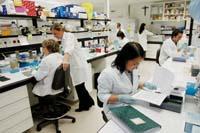As rare as serious

In Australia, the disease affecting one in ten thousand inhabitants is considered rare, while in Japan it affects four in ten thousand. Depending on the country and its socioeconomic situation, the definition of rare diseases varies slightly. However, the burden of these diseases is enormous in all places, both in mortality and in the disabilities and handicaps they cause. In Europe, approximately thirty million people suffer from one of the diseases considered rare.
Rare diseases exceed five thousand and more than 80% are of genetic origin. Most appear in childhood, but not all; amyotrophic lateral sclerosis (ALS), Huntington's disease, Crohn's disease, and scleroderma, for example, appear in adulthood.
These are chronic and degenerative diseases. And, given their gravity, they cannot be ignored or underestimated with the excuse of little incidence.
Common features Common features
Despite the enormous diversity of rare diseases, they have several common features. They are severe or very serious, chronic and often degenerative and, in general, significantly reduce the lives of people suffering from these diseases. About 50% of cases begin in childhood. The disability of the patients is very large, due to their lack of autonomy. They are incurable diseases or currently there is no effective treatment for their healing, although sometimes the quality of life of the patients can be improved. However, for the particular family, the burden is huge. Another characteristic of all these diseases is the lack of investment, which have no priority in public health and which in research is very little invested.
However, they are not entirely forgotten. For example, the company Digna Biotech is developing a drug to treat a strange skin disease: scleroderma. In particular, Digna Biotech develops on a preclinical, clinical and commercial level one of the patents of the Applied Medical Research Center of the University of Navarra.

Scleroderma
Scleroderma is a chronic disease that causes fibrosis in the skin, blood vessels, and internal organs such as the lungs. One of the most important factors for the development of this pathology is the excess of TGF Beta 1 cytokines, which are proteins that regulate cell functions among others. Currently there is no curative treatment.
It is a rare or rare disease affecting 37,000-72,000 patients in the European Union, and between 0.82 and 1.58 cases per 10,000 people. This small incidence makes it even more difficult to research new treatments.
Navarre researchers work with p144 peptide and want to develop it as a cream to give on the skin and treat systemic and localized scleroderma. Peptide is an inhibitor of the TGF Beta 1 factor that has already overcome animal research and the first toxicological analyses. Researchers expect the clinical phase of the product to begin at the end of the year.
This drug, in addition, has already received the name of orphan drug, both from the United States Food Agency (this year) and the European Medicines Agency (last year). According to Digna Biotech, these denominations accelerate the clinical development of the product and reduce costs. The name of orphan drug is a series of advantages for developing companies.
Also pulmonary fibrosis

On the other hand, technology companies Digna Biotech and Biotherapix have recently signed an agreement for the joint application of two products for the treatment of fibrosis caused by scleroderma, as well as other lung products. The agreement is based on the combination of protein M3 and p17 peptide. As a result of this combination, experts from technology companies want to find a way to combat pulmonary fibrosis.
Pulmonary fibrosis is an abnormal accumulation of collagen fibers that takes place in the lungs, but they still do not know why it occurs. This disease causes the deterioration of the lung structure. This causes a continuous pulmonary scarring that hinders the assimilation of oxygen, making it difficult to breathe. At present, pulmonary fibrosis is a rare or exceptional disease. 13 and 20 cases per 100,000 inhabitants, respectively, in women and men.
There are no effective treatments to cure this disease. Current treatments focus on oxygen and anti-inflammatory drugs, but these therapies do not help much to improve the quality of life of patients.
Continuous abrasion of the skin
Something similar occurs with a genetic skin disease, the epidermolisis puslosa with rare disease. Recently the Inbiomed Foundation of San Sebastian launched the first clinical trial through cell therapy against this disease. This disease, also known as "butterfly skin", affects two out of every one hundred thousand people. Eleven cases are known in the Autonomous Community of the Basque Country.
These patients have the absence of a protein that binds the dermis and epidermis. That is why their skin is very fragile, like the aspas of the butterflies. With the lowest abrasion, and often without any evident tear, there are various nostrils and wounds, not only in the skin, but also in mucous membranes, eyes, esophagus and intestines. This poses problems such as sight or feeding.

The trial will be based on the introduction of an artificial skin to patients. This artificial crust will be produced in the laboratories of Inbiomed from cells of the patient and a cell donor, and in some way it will act as adhesive between the dermis and the epidermis.
This project will participate, together with the Inbiomed Foundation, five hospitals and two research centers in Asturias, Catalonia, Madrid and Andalusia. The only objective is to find a solution to this pathology today incurable.
All of them are just a few examples. There are five thousand rare diseases and the path is long, but little by little you have to try to solve them. There are currently several rare disease centers that put in place special action plans, but it is not enough.





